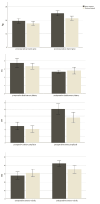The Influence of the Tissue Adhesive Material as a Surgical Wound-Closure Technique Following Carpal Tunnel Decompression on Neurological and Functional Outcomes: A Single-Center Randomized Controlled Trial
- PMID: 38435874
- PMCID: PMC10906781
- DOI: 10.7759/cureus.53312
The Influence of the Tissue Adhesive Material as a Surgical Wound-Closure Technique Following Carpal Tunnel Decompression on Neurological and Functional Outcomes: A Single-Center Randomized Controlled Trial
Abstract
Background Carpal tunnel syndrome (CTS) is caused by compression of the median nerve in the carpal tunnel. The effect of tissue adhesives as a material for wound closure following CTS decompression has been insufficiently investigated. This study aimed to evaluate outcomes by comparing two modalities of wound closure following carpal surgery in patients randomly assigned to either tissue adhesives or sutures. Methodology This randomized, prospective study was conducted in April 2022 at the University Hospital of Split in Croatia. Patients aged 61.56 ± 12.03 years were randomized to either tissue adhesive Glubran Tiss 2®-based (n = 50) or suture-based (n = 50) wound-closure techniques. The following outcomes were assessed before surgery and six months postoperatively: hand strength, electroneurographic characteristics of the median nerve, and the Boston Carpal Tunnel Questionnaire. Results Significant differences between glue-based and suture-based wound-closure techniques were found in the six-month postoperative hand grip strength (25.06 ± 6.69 vs. 21.41 ± 5.62 kg; p = 0.002), postoperative sensory amplitude (10.08 ± 5.50 vs. 7.54 ± 5.41 mV; p = 0.012), and postoperative sensory velocity (42.22 ± 11.04 vs. 35.23 ± 16.40 m/s; p = 0.008). In the glue-based group, significantly more patients achieved a postoperative sensory velocity greater than 45 m/s (47.9% vs. 22.0%; p= 0.006), postoperative distal sensory latency less than 3.5 ms (89.6% vs. 84.0%; p = 0.304), and postoperative motor latency of less than 4.2 ms (60.42% vs. 38.00%; p = 0.022). Conclusions This trial demonstrated that cyanoacrylate-based adhesion material for wound closure after open CTS decompression compared with sutures showed a significant six-month postoperative increment in hand grip strength and median nerve sensory conduction.
Keywords: carpal tunnel; cyanoacrylate; hand function; skin adhesive; skin suture.
Copyright © 2024, Sunjic Roguljic et al.
Conflict of interest statement
The authors have declared that no competing interests exist.
Figures



Similar articles
-
A Comparison of Tissue Adhesive Material and Suture as Wound-Closure Techniques following Carpal Tunnel Decompression: A Single-Center Randomized Control Trial.J Clin Med. 2023 Apr 14;12(8):2864. doi: 10.3390/jcm12082864. J Clin Med. 2023. PMID: 37109201 Free PMC article.
-
The Influence of Wound Closure Techniques after Surgical Decompression in Patients with Carpal Tunnel Syndrome on Sleep Disturbance and Life Quality: A Prospective Comparison of Surgical Techniques.Clin Pract. 2024 Mar 26;14(2):546-555. doi: 10.3390/clinpract14020042. Clin Pract. 2024. PMID: 38666800 Free PMC article.
-
Tissue Adhesive versus Skin Suture plus Waterproof Wound Dressings for Carpal Tunnel Wound Closure: A Prospective Randomized Controlled Trial.Malays Orthop J. 2024 Jul;18(2):63-70. doi: 10.5704/MOJ.2407.009. Malays Orthop J. 2024. PMID: 39130506 Free PMC article.
-
A Systematic Review of the Outcomes of Carpal Ligament Release in Severe Carpal Tunnel Syndrome.J Hand Surg Am. 2023 Apr;48(4):408.e1-408.e18. doi: 10.1016/j.jhsa.2021.11.015. Epub 2022 Jan 19. J Hand Surg Am. 2023. PMID: 35058091
-
Open versus endoscopic carpal tunnel release: a systematic review and meta-analysis of randomized controlled trials.BMC Musculoskelet Disord. 2020 Apr 27;21(1):272. doi: 10.1186/s12891-020-03306-1. BMC Musculoskelet Disord. 2020. PMID: 32340621 Free PMC article.
References
-
- Comparison of the histopathological findings of patients with diabetic and idiopathic carpal tunnel syndrome. Tekin F, Sürmeli M, Şimşek H, Ceran C, Tezcan S, Taner ÖF, Şimşek G. Int Orthop. 2015;39:2395–2401. - PubMed
-
- [Carpal tunnel syndrome: diagnosis, treatment, prevention and its relevance to dentistry] de Krom MC, de Krom CJ, Spaans F. https://pubmed.ncbi.nlm.nih.gov/19280893/ Ned Tijdschr Tandheelkd. 2009;116:97–101. - PubMed
-
- Neurophysiologic recovery after carpal tunnel release in diabetic patients. Thomsen NO, Rosén I, Dahlin LB. Clin Neurophysiol. 2010;121:1569–1573. - PubMed
-
- Conservative treatment in patients with mild to moderate carpal tunnel syndrome: a systematic review. Jiménez Del Barrio S, Bueno Gracia E, Hidalgo García C, Estébanez de Miguel E, Tricás Moreno JM, Rodríguez Marco S, Ceballos Laita L. Neurologia (Engl Ed) 2018;33:590–601. - PubMed
LinkOut - more resources
Full Text Sources
Research Materials
Miscellaneous
